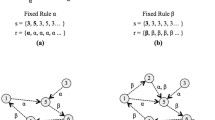Abstract
As embryonic arrays take inspiration from nature they display biological properties, namely complex structure and fault-tolerance. However, hardware implementations have yet to take advantage of a further biological feature at a fundamental level; asynchronous operation. Scalability and reliability are seen as two areas in which embryonic arrays could benefit from asynchronous design. This paper builds upon a previous asynchronous embryonic architecture simulation. The addition of a two-fold reconfiguration strategy that provides fault-tolerance is detailed. The simulation’s design is similar to that of a macromodule library that has been implemented using Xilinx Virtex FPGAs, bringing the possibility of truly asynchronous embryonic circuits a step closer.
Access this chapter
Tax calculation will be finalised at checkout
Purchases are for personal use only
Preview
Unable to display preview. Download preview PDF.
Similar content being viewed by others
References
Mange, D. et al. (2000), “Toward robust integrated circuits: The embryonics approach”, Proceedings of the IEEE, 88(4): 516–43.
Ortega-Sánchez, C. A. (2000), “Embryonics: A Bio-inspired Fault-tolerant Multicellular System”, D. Phil. Thesis, Bio-inspired and Bio-medical Engineering, The Department of Electronics, The University of York: 159.
Tempesti, G. (1998), “A Self-Repairing Multiplexer-Based FPGA Inspired by Biological Processes”, Ph.D. Thesis, Logic Systems Laboratory, Computer Science Department, Swiss Federal Institute of Technology: 166.
Ortega, C. & Tyrrell, A. (2000), “A Hardware Implementation of an Embryonic Architecture Using Virtex FPGAs”, Evolvable systems: from biology to hardware, Proceedings of 3rd International Conference (ICES2000), Lecture notes in Computer Science, 1801, 155–164, Miller, J. et al. (eds.), Springer-Verlag.
Jackson, A. H. & Tyrrell, A. M. (2001), “Asynchronous Embryonics”, Proceedings of 3rd NASA/DoD Workshop on Evolvable Hardware, IEEE Computer Society.
Hauck, S. (1995), “Asynchronous design methodologies: an overview”, Proceedings of the IEEE, 83(1): 69–93.
Brunvand, E. (1995), “Introduction to Asynchronous Circuits and Systems”, Tutorial, 2nd Working Conference on Asynchronous Design Methodologies, South Bank University, London, UK.
Davis, A. & Nowick, S. M. (1997), “An Introduction to Asynchronous Circuit Design”, University of Utah Department of Computer Science report, UUCS-97-013: 1–58.
McAuley, A. J. (1992), “Four state asynchronous architectures”, IEEE Transactions on Computers, 41(2): 129–42.
Sutherland, I. E. (1989), “Micropipelines”, Communications of the ACM, 32(6): 720–38.
Unger, S. H. (1995), “Hazards, critical races, and metastability”, IEEE Transactions on Computers, 44(6): 754–68.
Wakerly, J. F. (1994), “Digital design principles and practices”, (2nd ed.), Prentice Hall.
Nussbaum, P., Girau, B. & Tisserand, A. (1998), “Field programmable processor arrays”, Evolvable Systems: From Biology to Hardware, Proceedings of 2nd International Conference (ICES98), Lecture notes in Computer Science, 1478, 311–322, Sipper, M. et al. (eds.), Springer-Verlag.
Furber, S. B., Edwards, D. A. & Garside, J. D. (2000), “AMULET3: a 100 MIPS Asynchronous Embedded Processor”, Proceedings of IEEE International Conference on Computer Design: VLSI in Computers and Processors (ICCD2000), 329–334, IEEE Computer Society.
Ortega, C. & Tyrrell, A. (1998), “Evolvable hardware for fault-tolerant applications”, IEE Colloquium on Evolvable Hardware Systems (Digest No.1998/233), 30, IEE.
Author information
Authors and Affiliations
Editor information
Editors and Affiliations
Rights and permissions
Copyright information
© 2001 Springer-Verlag Berlin Heidelberg
About this paper
Cite this paper
Jackson, A.H., Tyrrell, A.M. (2001). Asynchronous Embryonics with Reconfiguration. In: Liu, Y., Tanaka, K., Iwata, M., Higuchi, T., Yasunaga, M. (eds) Evolvable Systems: From Biology to Hardware. ICES 2001. Lecture Notes in Computer Science, vol 2210. Springer, Berlin, Heidelberg. https://doi.org/10.1007/3-540-45443-8_8
Download citation
DOI: https://doi.org/10.1007/3-540-45443-8_8
Published:
Publisher Name: Springer, Berlin, Heidelberg
Print ISBN: 978-3-540-42671-4
Online ISBN: 978-3-540-45443-4
eBook Packages: Springer Book Archive




